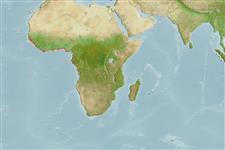Common names from other countries
Environment: milieu / climate zone / depth range / distribution range
Ecologia
marino; acqua dolce; salmastro benthopelagico. Tropical; 22°C - 26°C (Ref. 2059); 16°N - 12°S, 17°W - 16°E
Africa: coastal basins, fresh waters, brackish and marine waters from mouth of Senegal River (Senegal) to mouth of the Cuanza River (Angola) (Ref. 81260), sometimes ascending far up rivers.
Length at first maturity / Size / Peso / Age
Maturity: Lm 13.5, range 10 - ? cm
Max length : 30.0 cm SL maschio/sesso non determinato; (Ref. 31256)
Spine dorsali (totale): 14 - 16; Raggi dorsali molli (totale): 12-13; Spine anali 3; Raggi anali molli: 8 - 10. Diagnosis: upper profile of head strongly convex; lower pharyngeal bone about as long as broad, and with anterior lamella shorter than toothed area (Ref. 53405). 10 or fewer rakers on lower limb of first arch; unpaired fins not predominantly red-brown; mouth terminal; 29-30 scales on lateral line; outer row teeth robust (Ref. 81260). Dorsal fin with 14-16 spines and 12-13 soft rays (total rays 27-29) (Ref. 53405, 81260). Anal fin with 3 spines and 8-10 soft rays; caudal fin weakly covered with scales at base or entirely membranous (Ref. 81260). Caudal without spots, grey on upper lobe, yellow on lower; large vertical stripes weakly pronounced on flanks; flank scales with a blackish mark at base (Ref. 53405, 81260). No bifurcated dark vertical bars on flanks; dorsal and anal without orange-red upper margin (Ref. 53405). Length of caudal peduncle 10.5-12.9% of standard length (Ref. 81260).
Very tolerant of elevated salinities, found in pure seawater, even reproduction in these highly saline environments is possible (Ref. 52307). Feeds on shrimps, bivalves, plankton (Ref. 28587), detritus (Ref. 28587, 52307), higher plants, algae, aufwuchs and small crustaceans (Ref. 52307). Oviparous (Ref. 205). Very prolific, spawning up to every 3 weeks (Ref. 52307). Pair bonding, open (Ref. 52307) substrate brooder/spawner (Ref. 52307, 81260) with both parents guarding the brood (Ref. 52307).
Oviparous (Ref. 205). Subtrate guarding of eggs as a form of parental care is done by both male and female (Ref. 50828).
Dunz, A.R. and U.K. Schliewen, 2013. Molecular phylogeny and revised classification of the haplotilapiine cichlid fishes formerly referred to as "Tilapia". Mol. Phylogenet. Evol. 68(1):64-80. (Ref. 93285)
IUCN Red List Status (Ref. 130435)
CITES (Ref. 128078)
Not Evaluated
Threat to humans
Harmless
Human uses
Pesca: commerciale; Acquacoltura: commerciale
Informazioni ulteriori
CollaboratoriImmaginiStamps, Coins Misc.SuoniCiguateraVelocitàModalità di nuotoArea branchialeOtolithsCervelliVista
Strumenti
Special reports
Download XML
Fonti Internet
Estimates based on models
Preferred temperature (Ref.
115969): 25.5 - 28, mean 27.4 (based on 152 cells).
Phylogenetic diversity index (Ref.
82804): PD
50 = 0.5000 [Uniqueness, from 0.5 = low to 2.0 = high].
Bayesian length-weight: a=0.01514 (0.00942 - 0.02431), b=2.96 (2.83 - 3.09), in cm Total Length, based on LWR estimates for this species & (Sub)family-body (Ref.
93245).
Trophic level (Ref.
69278): 2.8 ±0.33 se; based on food items.
Resilienza (Ref.
120179): Alto, tempo minimo di raddoppiamento della popolazione meno di 15 mesi (K=0.47; Fec < 1,000).
Fishing Vulnerability (Ref.
59153): Low vulnerability (19 of 100).
